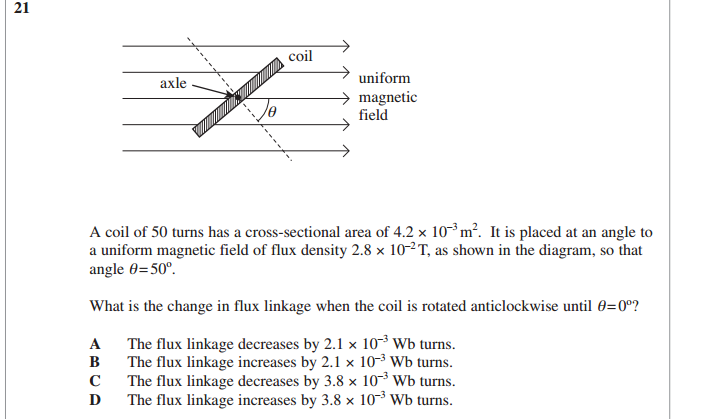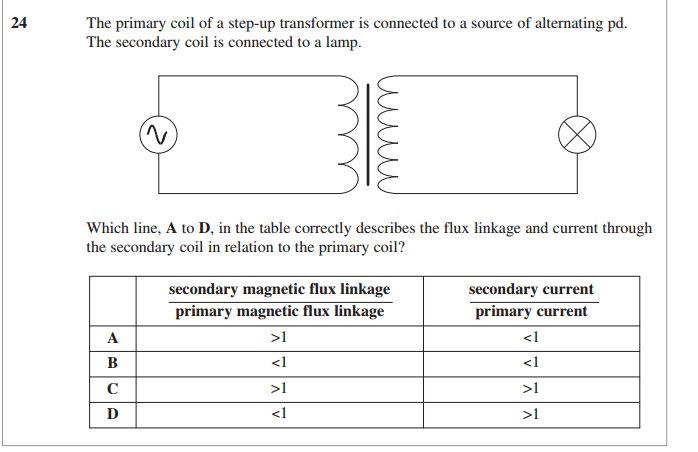AQA Physics PHYA4 - Thursday 11th June 2015 [Exam Discussion Thread]
Scroll to see replies

??
EQ=ma
Now solve as you know the charge and mass of an electron!
Posted from TSR Mobile
Alright cheers, I'll have another look at the power losses!
Posted from TSR Mobile
EDIT: Whoops silly mistake, now edited.
you sir are an angel! However - what part of the question implies that it's d+20x10^3 for the 0.5F part?
EDIT: nvm lol
EDIT: Sniped

FFS that's simple as ****, it's always the basic ones that get me
any quick method for working these out?



By Fleming's left hand rule the force acts at right angles to both the conventional current (opposite the velocity of the electron) and the field. Thus at any rate the force is at right angles to the field.
21) Answer: A.
.
At we have .
At we clearly just have , which is simply the previous answer divided by (since previous answer = ). Therefore .
It follows that , as claimed.
24) Answer: Not entirely sure about this one but I think it's A.
Step up transformer so . For any transformer at all it's obvious that (with equality if and only if it is 100% efficient). Therefore or where the final inequality follows from the fact that (see above). We also have since B,A and theta are all constant in this situation (and ). Therefore .
24 is A yep.
21) that was my initial approach of doing things but I didn't follow through unfortunately
Well done mate proud of you have a gold star
Posted from TSR Mobile
any quick method for working these out?
The difference between them is 0.05
If you want to find Q you divide P by 0.05 and that will give you the number
Don't know how it works though lol
Posted from TSR Mobile
Posted from TSR Mobile
By Fleming's left hand rule the force acts at right angles to both the conventional current (opposite the velocity of the electron) and the field. Thus at any rate the force is at right angles to the field.
21) Answer: A.
.
At we have .
At we clearly just have , which is simply the previous answer divided by (since previous answer = ). Therefore .
It follows that , as claimed.
24) Answer: Not entirely sure about this one but I think it's A.
Step up transformer so . For any transformer at all it's obvious that (with equality if and only if it is 100% efficient). Therefore or where the final inequality follows from the fact that (see above). We also have since B,A and theta are all constant in this situation (and ). Therefore .
Wouldn't 21 be B) ? You're increasing flux linkage.
Posted from TSR Mobile
In my chemistry exam :/ which is also in the afternoon, for bonus annoyingness for physics! And I have come down the the cold from hell so hopefully the revision I've done so far will be enough with a quick recap tomorrow evening
1
The bindings around the core need to be of low resistance as possible. As when the large AC current flows a hearing effect in the current occurs. Using thick copper is best. This is most important on the higher current side of the transformer (so in a step up voltage is less on the primary coil therefore current must be more, as power has to be conserved.
2
The AC current de magnitizes and magnitizes the core continuously in opposite directions due to the AC current traveling around the core. This means that the metal need to be magnetically soft so that no energy Is lost when the magnetic flow reverses. Iron is used.
3
Core design- if there is a large distance between the two coils this can be inefficient and energy wasted. By better design, such as placing the coils on top of each other this can be reduced.
4
To prevent the phenomenon of eddy currents the core needs to be laminated. As the magnetic flux passing through the core is changing continuously the core is being cut by flux continuously changes emf. This heats the core. Separating the magnetic core prevent unnecessary flux being cut
Hope this help! Hope they come up too! Just done this from memory
Posted from TSR Mobile
Posted from TSR Mobile
Get well soon! Core 4 wasn't great - spent my day drowning my sorrows and being unproductive haha. Good luck for Chem!
Posted from TSR Mobile
Light: The amplitude of oscillation reduces slowly over time.
Heavy: Amplitude of oscillation reduces more quickly over time than for a lightly damped system
Critical: The system doesn't oscillate but returns to its equilibrium position in the shortest possible time (in less than one cycle, due to no oscillation)
Overdamping: The system doesn't oscillate but also doesn't return to its equilibrium position. This is why you would perhaps not want to overdamp a car suspension system (car won't return to equilibrium, which is bad). You can think of this as a pendulum moving through a thick gooey substance from maximum displacement
Those are the general ideas anyway.
Thanks a lot!
Thanks!
Quick Reply
Related discussions
- A-level Exam Discussions 2024
- GCSE Exam Discussions 2024
- AQA A Level Sociology Paper 3 (7192/3) - 11th June 2024 [Exam Chat]
- AQA A-level Mathematics Paper 2 (7357/2) - 11th June 2024 [Exam Chat]
- A Level Exam Discussions 2023
- AQA GCSE Physics Paper 2 (Foundation Tier triple) 8463/2F - 16th Jun 2023 [Exam Chat]
- Edexcel GCSE Combined Science Paper 5 Chem 2 Higher - 11th June 2024 [Exam Chat]
- OCR B A-level Physics Paper 2 Advancing Physics (H557/02) - 9th June 2023 [Exam Chat]
- Edexcel GCSE Combined Science Paper 5 Chem 2 Foundation - 11th June 2024 [Exam Chat]
- AQA GCSE Physics Paper 2 (Foundation Combined) 8464/2F - 16th June 2023 [Exam Chat]
- GCSE Exam Discussions 2023
- AQA GCSE Physical sciences (Foundation Combined) 8465/3F - 9th June 2023 [Exam Chat]
- AQA GCSE Physical sciences (Higher Combined) 8465/3H - 9th June 2023 [Exam Chat]
- AQA GCSE Physical sciences (Foundation Combined) 8465/4F - 13th June 2023 [Exam Chat]
- AQA GCSE Physical sciences (Higher Combined) 8465/4H - 13th June 2023 [Exam Chat]
- Edexcel A Level Mathematics Paper 2 (9MA0 02) - 11th June 2024 [Exam Chat]
- OCR A Level Mathematics B (MEI) Paper 2 (H640/02) - 11th June 2024 [Exam Chat]
- OCR A A-level Physics Paper 1 Modelling Physics (H556/01) - 24th May 2024 [Exam Chat]
- OCR A-level Sociology Paper 3 (H580/03) - 11th June 2024 [Exam Chat]
- OCR B A-level Physics Paper 3 Advancing Physics (H557/03) - 15th Jun 2023 [Exam Chat]
Latest
Last reply 1 minute ago
TSR Study Together - STEM vs Humanities - Ninth SessionLast reply 1 minute ago
HSBC Degree Apprenticeship 2024Last reply 2 minutes ago
Does applying for higher maintenance loan delay tuition fees if complications happenLast reply 3 minutes ago
MSc Computer Science (conversion course) 2024-2025Last reply 3 minutes ago
Official Cambridge Postgraduate Applicants 2024 ThreadLast reply 4 minutes ago
Home Office: Immigration Enforcement Casework Support AO 2024Last reply 7 minutes ago
Official: Aston University A100 2024 Entry Applicant thread1112
Last reply 10 minutes ago
LSE International Social and Public Policy and Economics (LLK1) 2024 ThreadLast reply 10 minutes ago
Microsoft apprenticeship 2024Trending
Last reply 3 days ago
AQA GCSE Physics Paper 1 (Higher Combined) 8464/1H - 22nd May 2024 [Exam Chat]Last reply 1 week ago
OCR A A-level Physics Paper 1 Modelling Physics (H556/01) - 24th May 2024 [Exam Chat]Last reply 4 weeks ago
AQA GCSE Physics Paper 2 (Higher Tier triple) 8463/2H - 16th June 2023 [Exam Chat]Last reply 1 month ago
AQA A-level Physics Paper 2 (7408/2) - 9th June 2023 [Exam Chat]Last reply 1 month ago
AQA GCSE Physics Paper 2 (Higher Combined) 8464/2H - 16th June 2023 [Exam Chat]Last reply 1 month ago
Edexcel A Level Physics Paper 3: 9PH0 03 - 15th June 2023 [Exam Chat]Last reply 3 months ago
AQA A-level Physics Paper 1 (7408/1) - 24th May 2023 [Exam Chat]1190
Last reply 4 months ago
Edexcel GCSE Physics Paper 1 Higher Combined 1SC0 1PH - 25th May 2023 [Exam Chat]Last reply 4 months ago
Edexcel GCSE Physics Paper 1 Higher Tier Triple 1PH0 1H - 25th May 2023 [Exam Chat]Last reply 4 months ago
AQA GCSE Physics Paper 1 (Higher Combined) 8464/1H - 25th May 2023 [Exam Chat]Last reply 5 months ago
AQA GCSE Physics Paper 1 (Higher Tier triple) 8463/1H - 25th May 2023 [Exam Chat]Last reply 5 months ago
AQA A-level Physics Paper 3 (7408/3) - 15th June 2023 [Exam Chat]Last reply 10 months ago
Edexcel GCSE Physics Paper 2 Higher Tier Triple 1PH0 2H - 16th June 2023 [Exam Chat]Last reply 10 months ago
OCR B A-level Physics Paper 3 Advancing Physics (H557/03) - 15th Jun 2023 [Exam Chat]Last reply 10 months ago
OCR GCSE Physics A Paper 4 Higher Tier (J249/04) - 16th June 2023 [Exam Chat]Last reply 10 months ago
AQA GCSE Physics Paper 2 (Foundation Combined) 8464/2F - 16th June 2023 [Exam Chat]Last reply 10 months ago
Edexcel A Level Physics Paper 1: Advanced Physics I 9PH0 01 - 24 May 2023 [Exam Chat]Last reply 10 months ago
Edexcel A Level Physics Advanced Physics II 9PH0 02 - 9th June 2023 [Exam Chat]Trending
Last reply 3 days ago
AQA GCSE Physics Paper 1 (Higher Combined) 8464/1H - 22nd May 2024 [Exam Chat]Last reply 1 week ago
OCR A A-level Physics Paper 1 Modelling Physics (H556/01) - 24th May 2024 [Exam Chat]Last reply 4 weeks ago
AQA GCSE Physics Paper 2 (Higher Tier triple) 8463/2H - 16th June 2023 [Exam Chat]Last reply 1 month ago
AQA A-level Physics Paper 2 (7408/2) - 9th June 2023 [Exam Chat]Last reply 1 month ago
AQA GCSE Physics Paper 2 (Higher Combined) 8464/2H - 16th June 2023 [Exam Chat]Last reply 1 month ago
Edexcel A Level Physics Paper 3: 9PH0 03 - 15th June 2023 [Exam Chat]Last reply 3 months ago
AQA A-level Physics Paper 1 (7408/1) - 24th May 2023 [Exam Chat]1190
Last reply 4 months ago
Edexcel GCSE Physics Paper 1 Higher Combined 1SC0 1PH - 25th May 2023 [Exam Chat]Last reply 4 months ago
Edexcel GCSE Physics Paper 1 Higher Tier Triple 1PH0 1H - 25th May 2023 [Exam Chat]Last reply 4 months ago
AQA GCSE Physics Paper 1 (Higher Combined) 8464/1H - 25th May 2023 [Exam Chat]Last reply 5 months ago
AQA GCSE Physics Paper 1 (Higher Tier triple) 8463/1H - 25th May 2023 [Exam Chat]Last reply 5 months ago
AQA A-level Physics Paper 3 (7408/3) - 15th June 2023 [Exam Chat]Last reply 10 months ago
Edexcel GCSE Physics Paper 2 Higher Tier Triple 1PH0 2H - 16th June 2023 [Exam Chat]Last reply 10 months ago
OCR B A-level Physics Paper 3 Advancing Physics (H557/03) - 15th Jun 2023 [Exam Chat]Last reply 10 months ago
OCR GCSE Physics A Paper 4 Higher Tier (J249/04) - 16th June 2023 [Exam Chat]Last reply 10 months ago
AQA GCSE Physics Paper 2 (Foundation Combined) 8464/2F - 16th June 2023 [Exam Chat]Last reply 10 months ago
Edexcel A Level Physics Paper 1: Advanced Physics I 9PH0 01 - 24 May 2023 [Exam Chat]Last reply 10 months ago
Edexcel A Level Physics Advanced Physics II 9PH0 02 - 9th June 2023 [Exam Chat]




